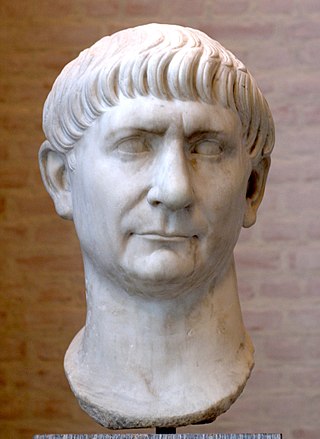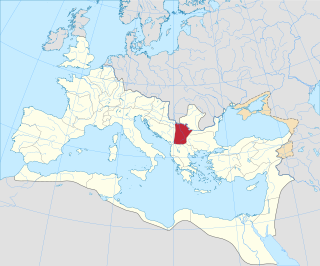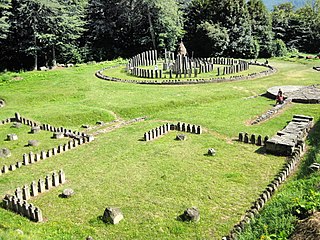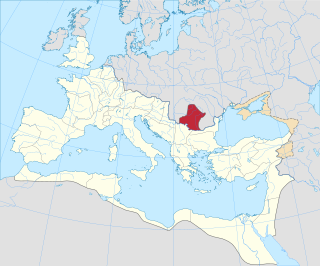This article needs additional citations for verification .(May 2012) |

The Decebalus treasure is an account detailed by Cassius Dio about events said to have happened in the Roman world during the 2nd century AD.
This article needs additional citations for verification .(May 2012) |

The Decebalus treasure is an account detailed by Cassius Dio about events said to have happened in the Roman world during the 2nd century AD.


During the Second Dacian War (105–106), many Dacian nobles surrendered or were caught. One of them, Bicilis, disclosed the location of a treasure, supposedly buried at the bottom of a river.
"The treasures of Decebalus were also discovered, though hidden beneath the river Sargetia, which ran past his palace. With the help of some captives Decebalus had diverted the course of the river, made an excavation in its bed, and into the cavity had thrown a large amount of silver and gold and other objects of great value that could stand a certain amount of moisture; then he had heaped stones over them and piled on earth, afterwards bringing the river back into his course. He also had caused the same captives to deposit his robes and other articles of a like nature in caves, and after accomplishing this had made away with them to prevent them from disclosing anything. But Bicilis, a companion of his who knew what had been done, was seized and gave information about these things." [1]
According to the story, the Dacian king Decebalus (reigned 87–106) used Roman prisoners to deviate the course of the Sargetia river and buried a treasure at the bottom. He buried "so much silver and gold and some other artefacts who can survive moisture", after which the river was returned to its original course. The rest of the treasure was deposited in surrounding caves, and the Roman prisoners were slaughtered. [2]
T. Statilius Crito of Heraclea, Trajan's procurator and medic, compiling a Getica[ clarification needed ], wrote that the Decebalus treasure included 5,000,000 lbs (2,200 tonnes) of gold and 10,000,000 lbs (4,500 tonnes) of silver. Some modern historians, such as Julian Bennett, believe that this is a copy error.[ citation needed ]
Jérôme Carcopino has estimated the treasure at 165,500 kg of gold and 331,000 kg of silver. [3] Between 1540 and 1759, in Sarmizegetusa Regia, 700 kg of gold was discovered, and much more was found in the 19th century. [4]
The Roman claim that they looted in a single hoard 165 tons of gold and 300 tons of silver is accepted by some[ which? ] historians. This amount is perhaps credible in terms of the massive Dacian exploitation of precious metals in the Apuseni Mountains, along with trade payments and tributes from abroad (including from the Roman empire) paid to Dacia. Also, its existence in one spot suggests that the Dacian state had central control of precious metal circulation. [5]

Trajan was Roman emperor from 98 to 117 AD, the second of the Five Good Emperors of the Nerva–Antonine dynasty. He was a philanthropic ruler and a successful soldier-emperor who led the Roman Empire to its greatest territorial extent by the time of his death. He was given the title of optimus by the Roman Senate.

Dacia was the land inhabited by the Dacians, its core in Transylvania, stretching to the Danube in the south, the Black Sea in the east, and the Tisza in the west. The Carpathian Mountains were located in the middle of Dacia. It thus roughly corresponds to the present-day countries of Romania, as well as parts of Moldova, Bulgaria, Serbia, Hungary, Slovakia, and Ukraine.

Moesia was an ancient region and later Roman province situated in the Balkans south of the Danube River. Moesian Province was first administered by governor of Noricum as 'Civitates of Moesia and Triballia'. It included most of the territory of modern eastern Serbia, Kosovo, north-eastern Albania, northern parts of North Macedonia, Northern Bulgaria, Romanian Dobruja and small parts of Southern Ukraine.

The Dacians were the ancient Indo-European inhabitants of the cultural region of Dacia, located in the area near the Carpathian Mountains and west of the Black Sea. They are often considered a subgroup of the Thracians. This area includes mainly the present-day countries of Romania and Moldova, as well as parts of Ukraine, Eastern Serbia, Northern Bulgaria, Slovakia, Hungary and Southern Poland. The Dacians and the related Getae spoke the Dacian language, which has a debated relationship with the neighbouring Thracian language and may be a subgroup of it. Dacians were somewhat culturally influenced by the neighbouring Scythians and by the Celtic invaders of the 4th century BC.

Decebalus, sometimes referred to as Diurpaneus, was the last Dacian king. He is famous for fighting three wars, with varying success, against the Roman Empire under two emperors. After raiding south across the Danube, he defeated a Roman invasion in the reign of Domitian, securing a period of independence during which Decebalus consolidated his rule.

Buried treasure is a literary trope commonly associated with depictions of pirates, vikings, criminals, and Old West outlaws. According to popular conception, these people often buried their stolen fortunes in remote places, intending to return to them later.

The Kosons are the only gold coins that have been minted by the Dacians, named after the Greek alphabet inscription "ΚΟΣΩΝ" on them. It is thought that "Koson" is the name of an otherwise historically unrecorded Dacian king, though he may be identical to the Cotison mentioned by Horace and Suetonius.
The Dacian Wars were two military campaigns fought between the Roman Empire and Dacia during Emperor Trajan's rule. The conflicts were triggered by the constant Dacian threat on the Danubian province of Moesia and also by the increasing need for resources of the economy of the Empire.
Lucius Licinius Sura was an influential Roman Senator from Tarraco, Hispania, a close friend of the Emperor Trajan and three times consul, in a period when three consulates were very rare for non-members of the Imperial family. The dates of two of these consulates are certain: in 102 and 107 AD he was consul ordinarius; the date of his first consulate, as a suffect consul has been debated. Fausto Zevi postulated that he was also suffect consul in 97, based on a plausible restoration of part of the Fasti Ostienses, which reads "..]us". However, two more recently recovered fragments of military diplomas show that the name of this consul is L. Pomponius Maternus, who is otherwise unknown. Most authorities have returned to endorsing C.P. Jones' surmise that Sura was consul for the first time in the year 93. He was a correspondent of Pliny the Younger.

Domitian's Dacian War was a conflict between the Roman Empire and the Dacian Kingdom, which had invaded the province of Moesia. The war occurred during the reign of the Roman emperor Domitian, in the years 86–88 AD.

The Battle of Adamclisi was a major battle in the Dacian Wars, fought in the winter of 101 to 102 between the Roman Empire and the Dacians near Adamclisi, in modern Romania.
The Second Roman–Dacian War was fought between 105 and 106 because the Dacian king, Decebalus, had broken his peace terms with the Roman Emperor Trajan from the First Dacian War.

Tiberius Claudius Maximus was a cavalryman in the Imperial Roman army who served in the Roman legions and Auxilia under the emperors Domitian and Trajan in the period AD 85–117. He is noted for presenting Trajan with the head of Dacian king Decebalus, who had committed suicide after being surrounded by Roman cavalry at the end of Dacian Wars.
Gnaeus Pompeius Longinus was a Roman senator and general. He was the 5th legate of Judaea from 85 to 89 and held the suffect consulship in the nundinium of September–October 90 as the colleague of Lucius Albius Pullaienus Pollio. He was deceived into a trap by Decebalus during Trajan's Second Dacian War, and rather than provide an advantage to the Dacian king, killed himself.

The Battle of Sarmizegetusa was a siege of Sarmizegetusa, the capital of Dacia, fought in 106 between the army of the Roman Emperor Trajan, and the Dacians led by King Decebalus.

The Ludus Dacicus or The Dacian Gladiatorial Training School was one of the four gladiator training schools (ludi) in Ancient Rome. It was founded by Domitian, completed by Trajan, and was used to train gladiators drawn from among the Dacian prisoners taken by both emperors in their Dacian Wars. It was located east of the Colosseum, on the slopes of the Caelian Hill.

The Column is a 1968 Romanian historical film directed by Mircea Drăgan. The film was selected as the Romanian entry for the Best Foreign Language Film at the 41st Academy Awards, but was not accepted as a nominee.

Roman Dacia was a province of the Roman Empire from 106 to 271–275 AD. Its territory consisted of what are now the regions of Oltenia, Transylvania and Banat. During Roman rule, it was organized as an imperial province on the borders of the empire. It is estimated that the population of Roman Dacia ranged from 650,000 to 1,200,000. It was conquered by Trajan (98–117) after two campaigns that devastated the Dacian Kingdom of Decebalus. However, the Romans did not occupy its entirety; Crișana, Maramureș, and most of Moldavia remained under the Free Dacians.
The Antiquity in Romania spans the period between the foundation of Greek colonies in present-day Dobruja and the withdrawal of the Romans from "Dacia Trajana" province. The earliest records of the history of the regions which now form Romania were made after the establishment of three Greek towns—Histria, Tomis, and Callatis—on the Black Sea coast in the 7th and 6th centuries BC. They developed into important centers of commerce and had a close relationship with the natives. The latter were first described by Herodotus, who made mention of the Getae of the Lower Danube region, the Agathyrsi of Transylvania and the Sygannae of Crişana.

Tiberius Claudius Livianus was an eques and general who was appointed praetorian prefect by Trajan, playing an important role in his First Dacian War, and continued as prefect into the reign of Hadrian. His full name, as attested in an inscription found in Rome, is Tiberius Julius Aquilinus Castricius Saturninus Claudius Livianus.